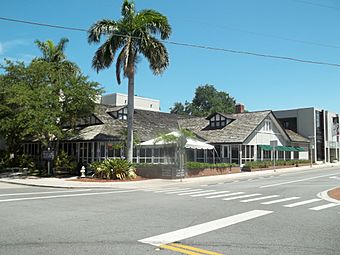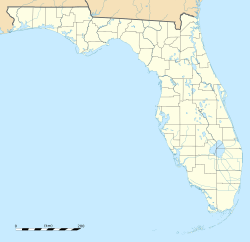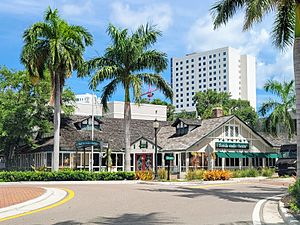Sarasota Woman's Club facts for kids
Quick facts for kids |
|
|
Sarasota Woman's Club
|
|
 |
|
| Location | Sarasota, Florida |
|---|---|
| Built | 1915 |
| Architect | G. L. Lysat and H. N. Hall |
| Architectural style | Tudor Revival |
| MPS | Sarasota MRA |
| NRHP reference No. | 85000087 |
| Added to NRHP | January 18, 1985 |
The Sarasota Woman's Club is a historic building in Sarasota, Florida. It was built in 1915 to be the home of a new club for women. Because of its importance to American history, it was added to the National Register of Historic Places in 1985.
Today, the building is known as the Keating Theater. It is the main stage for the Florida Studio Theatre, a popular place to see plays and performances.
Contents
A Club for a Growing City
The Sarasota Woman's Club was started by 63 women on April 14, 1913. At that time, Sarasota was just becoming a city. The women wanted to help improve their new community.
Building a Clubhouse
After two years of activities, the club was ready for its own building. On January 1, 1915, they held a special ceremony to lay the cornerstone (the first stone set in a building's foundation). The club's first president, Alice Guenther, gave a speech.
The clubhouse was built for $4,500. It was designed in a style called Tudor Revival, which was inspired by old English country houses. For many years, part of the building was used as Sarasota's public library. The club members ran the library with money they raised until 1940.
In 1977, the building was officially recognized as a Historical Site.
What Did People Think?
When the club first started, a local newspaper, the Sarasota Sun, asked people what they thought. Many people, including the mayor, praised the club. They said the women were doing great things for the city.
Mayor Higel said, "Best move ever made here." Another resident, W.T. Caven, noted that cities with a woman's club showed "greater progress in its culture and municipal worth."
Some of the men made jokes about the club. The husband of the club's president joked that he would be "buttonless, sockless and half-fed for the next year" because his wife would be so busy. Overall, most people saw the club as a very positive force in Sarasota.
Making a Difference in Sarasota
Before the Woman's Club, many of the same women were part of the Town Improvement Society, which started in 1903. Their first project was to build sidewalks on Main Street, which was just sand paths before. They also put up lanterns at the train station and started the first library.
The Woman's Club continued this work to make Sarasota a better place to live.
Early Projects
The club had many committees that focused on different parts of community life, like the library, the local cemetery, and education.
In 1913, they took over the library and began fixing up the Rosemary Cemetery. They also organized a community work day. The mayor closed all the businesses, and over 200 men helped create a park along the bay. The next year, they planted 250 coconut trees along the shore.
The club also focused on health and education. They sold special stamps to raise money to fight Tuberculosis. They also worked to find ways to make school more affordable for families.
Helping During Wartime
During World War I, the women of the club wanted to help the country. In 1917, 61 members signed up to help with the war effort. They wrote down all their skills, from cooking to office work, so they could be called on to help when needed.
The club also started a Red Cross group and organized training classes for students in elementary school.
Supporting the Community Today
The club's work has continued for over 100 years. In 1938, they started the Helen R. Payne Day Care Nursery to help the children of migrant workers.
Today, the Woman's Club of Sarasota supports many local and national groups, including:
- Canine Companions for Independence
- Special Olympics
- The Everglades National Park
- Local libraries and schools
- Scholarship funds for students
- The American Cancer Society
- Food banks and shelters for the homeless
The Clubhouse Through the Years
The clubhouse was always a busy place. The club members organized their years into "seasons," with different themes and events.
A Place for Fun and Learning
The club hosted many fun events to raise money. In 1916, a party with a Mother Goose theme raised the most money of the year. In 1919, they held a "Colonial Ball" where couples dressed up in old-fashioned clothes.
They also held educational events. In 1921, they had a discussion about "The Censorship of the Movies." They also had guest speakers, book reviews, and art presentations. One season in the 1950s included a seminar on business tips for women.
Any money raised that wasn't used to run the clubhouse was given back to the community or to other charities.
The Club's Guiding Words
The Sarasota Woman's Club published its rules in the local newspaper, The Sarasota Times. They also had a set of "Brighten Up Rules" that members believed in. These rules encouraged members to be cheerful, improve their homes and town, and enjoy nature.
The club was also inspired by a poem called "What is a Woman's Club?" The poem describes a woman's club as a place where people with strong goals come together to make the world a better place.
The Building Today: A Home for Theater
Today, the historic clubhouse is the home of the Florida Studio Theatre (FST). In 1976, the building was empty and needed many repairs. The founder of FST, Jon Spelman, saw it as a perfect place for a theater.
A local supporter of the arts, Marian McKenna, bought the building and sold it to FST for a much lower price. FST has since renovated the building, keeping its historic look on the outside while creating a modern theater inside.
The old clubhouse is now the Keating Theatre, which has 173 seats. It is one of five theaters run by FST, which welcomes over 230,000 people every year.




